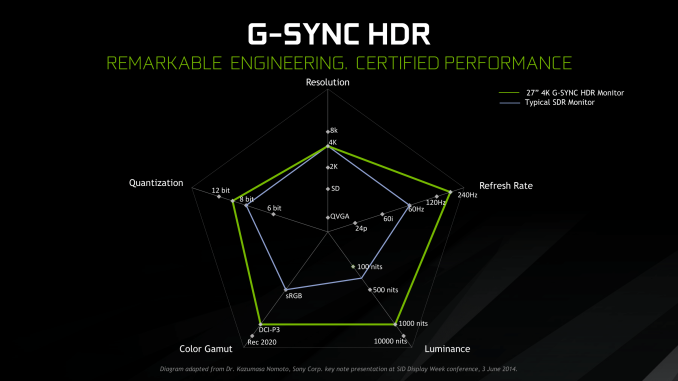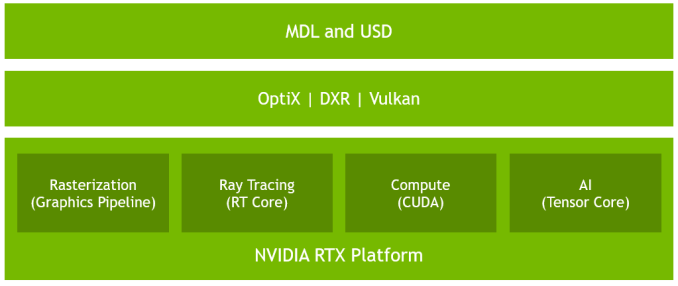The NVIDIA GeForce RTX 2080 Ti & RTX 2080 Founders Edition Review: Foundations For A Ray Traced Future
by Nate Oh on September 19, 2018 5:15 PM EST- Posted in
- GPUs
- Raytrace
- GeForce
- NVIDIA
- DirectX Raytracing
- Turing
- GeForce RTX
Meet The New Future of Gaming: Different Than The Old One
Up until last month, NVIDIA had been pushing a different, more conventional future for gaming and video cards, perhaps best exemplified by their recent launch of 27-in 4K G-Sync HDR monitors, courtesy of Asus and Acer. The specifications and display represented – and still represents – the aspired capabilities of PC gaming graphics: 4K resolution, 144 Hz refresh rate with G-Sync variable refresh, and high-quality HDR. The future was maxing out graphics settings on a game with high visual fidelity, enabling HDR, and rendering at 4K with triple-digit average framerate on a large screen. That target was not achievable by current performance, at least, certainly not by single-GPU cards. In the past, multi-GPU configurations were a stronger option provided that stuttering was not an issue, but recent years have seen both AMD and NVIDIA take a step back from CrossFireX and SLI, respectively.
Particularly with HDR, NVIDIA expressed a qualitative rather than quantitative enhancement in the gaming experience. Faster framerates and higher resolutions were more known quantities, easily demoed and with more intuitive benefits – though in the past there was the perception of 30fps as cinematic, and currently 1080p still remains stubbornly popular – where higher resolution means more possibility for details, higher even framerates meant smoother gameplay and video. Variable refresh rate technology soon followed, resolving the screen-tearing/V-Sync input lag dilemma, though again it took time to catch on to where it is now – nigh mandatory for a higher-end gaming monitor.
For gaming displays, HDR was substantively different than adding graphical details or allowing smoother gameplay and playback, because it meant a new dimension of ‘more possible colors’ and ‘brighter whites and darker blacks’ to gaming. Because HDR capability required support from the entire graphical chain, as well as high-quality HDR monitor and content to fully take advantage, it was harder to showcase. Added to the other aspects of high-end gaming graphics and pending the further development of VR, this was the future on the horizon for GPUs.
But today NVIDIA is switching gears, going to the fundamental way computer graphics are modelled in games today. Of the more realistic rendering processes, light can be emulated as rays that emit from their respective sources, but computing even a subset of the number of rays and their interactions (reflection, refraction, etc.) in a bounded space is so intensive that real time rendering was impossible. But to get the performance needed to render in real time, rasterization essentially boils down 3D objects as 2D representations to simplify the computations, significantly faking the behavior of light.
It’s on real time ray tracing that NVIDIA is staking its claim with GeForce RTX and Turing’s RT Cores. Covered more in-depth in our architecture article, NVIDIA’s real time ray tracing implementation takes all the shortcuts it can get, incorporating select real time ray tracing effects with significant denoising but keeping rasterization for everything else. Unfortunately, this hybrid rendering isn’t orthogonal to the previous concepts. Now, the ultimate experience would be hybrid rendered 4K with HDR support at high, steady, and variable framerates, though GPUs didn’t have enough performance to get to that point under traditional rasterization.
There’s a still a performance cost incurred with real time ray tracing effects, except right now only NVIDIA and developers have a clear idea of what it is. What we can say is that utilizing real time ray tracing effects in games may require sacrificing some or all three of high resolution, ultra high framerates, and HDR. HDR is limited by game support more than anything else. But the first two have arguably minimum performance standards when it comes to modern high-end gaming on PC – anything under 1080p is completely unpalatable, and anything under 30fps or more realistically 45 to 60fps hurts the playability. Variable refresh rate can mitigate the latter and framedrops are temporary, but low resolution is forever.
Ultimately, the real time ray tracing support needs to be implemented by developers via a supporting API like DXR – and many have been working hard on doing so – but currently there is no public timeline of application support for real time ray tracing, Tensor Core accelerated AI features, and Turing advanced shading. The list of games with support for Turing features - collectively called the RTX platform - will be available and updated on NVIDIA's site.













337 Comments
View All Comments
Makaveli - Wednesday, September 19, 2018 - link
lol that distinct impression is your own personal bias.A High price is a High price regardless of who's logo is on it.
Nagorak - Thursday, September 20, 2018 - link
Probably because you yourself are a fanboy.Spunjji - Friday, September 21, 2018 - link
And your evidence for that assertion is... presumably still up your ass, as you have yet to pull it out.wavetrex - Wednesday, September 19, 2018 - link
Wow... another review which is comparing shitty Pascal FE to Turding FE and unrealistic MRSP to MRSP.Instead of comparing... you know, actual cards that you can buy (partner cards), at the prices they are at ?
How much are Nvidia paying you guys to write such biased, unrealistic review, to attempt to salvage this disastrous launch ?
Sometimes I wonder why haven't I already removed Anandtech from my bookmarks yet.
I might just do that after I finish posting this comment.
diehardmacfan - Wednesday, September 19, 2018 - link
Are they supposed to have a real-time pricing information link to what each card will cost?If you think they got paid to offer up a less than glowing review.. lol.
DigitalFreak - Wednesday, September 19, 2018 - link
There are plenty of other reviews out there you can read.DILLIGAFF - Wednesday, September 19, 2018 - link
reminds me of something...... same situation and outcome..pushing new tek the hardware is horrible price/perf https://www.anandtech.com/show/742/12from geforce 3 it took till geforce 6 to get a nvidia gpu that was good on performance and price...i guess 1200 bux is the new 500 bux
maroon1 - Wednesday, September 19, 2018 - link
Huge gains in Wolfenstein II when using vulkanI like to see Doom with Vulkan test please
FirstStrike - Wednesday, September 19, 2018 - link
The computing benchmark really means a lot. But I wonder why GTX-10 series are absent in SGEMM tests. They should be able to get quite some GFLOPs in SGEMM.godrilla - Wednesday, September 19, 2018 - link
Nvidia could be capping performance of turing to make pascal look good in comparison to sell remaining stock which is a win win for nvidia they don't have to discount pascal to maintain max profits. Look at most convulsions saying pascal is still competitive in comparison to the 2080. Unfortunately we don't have a choice in a monopoly. When intel enters the gpu market we are probably going to have the most competition in a long time even if its mid level.